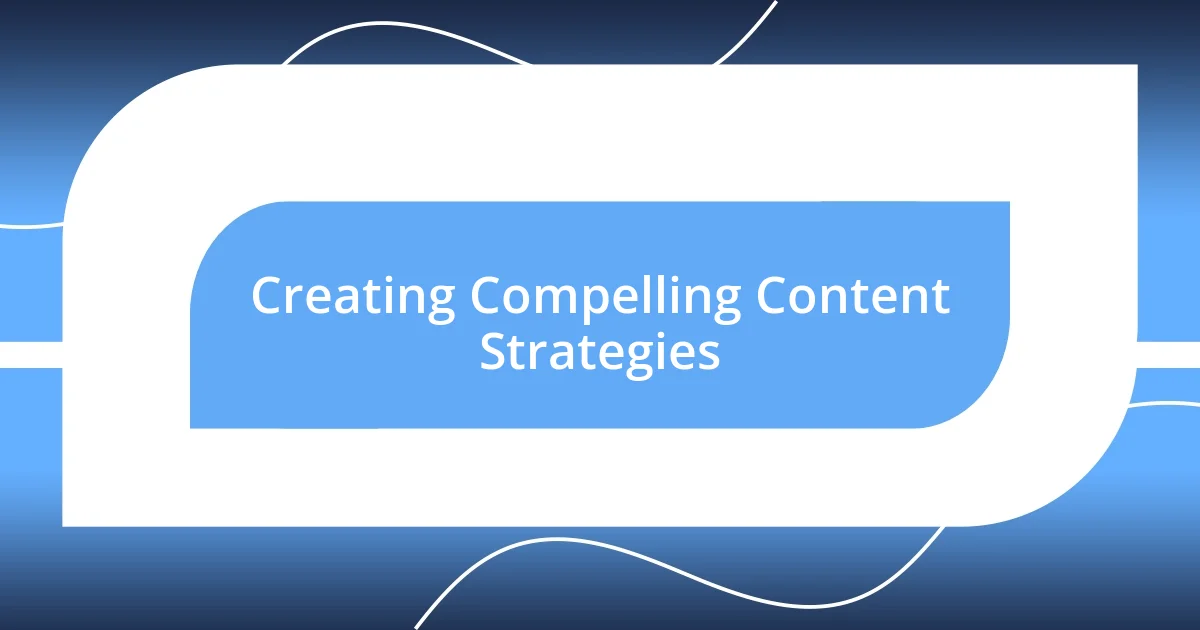Key takeaways:
- User engagement fosters loyalty and community, emphasizing the importance of empathy and emotional connections with users.
- Identifying target audience needs through surveys, user behavior analysis, and conversations enhances engagement strategies.
- Data-driven insights and continuous testing of engagement tactics lead to improved user experiences and effective content strategies.

Understanding User Engagement Importance
User engagement is crucial because it reflects how well you connect with your audience. In my experience, I’ve seen that when users feel valued and involved, they don’t just stick around—they become advocates. It really makes me wonder: how can we create that same feeling for all users?
Deepening user engagement often leads to richer experiences for both parties. I remember a particular project where I actively sought feedback from users, turning their insights into actionable changes. The transformation astounded me; users felt a sense of ownership, which strengthened their commitment and loyalty to our platform. Isn’t it fascinating how that mutual investment can ignite enthusiasm?
Moreover, the emotional aspect of engagement can’t be underestimated. Engaged users often share personal stories and experiences that resonate with others and create a sense of community. This has taught me that empathy is a powerful tool in fostering engagement. How often do we consider the feelings behind users’ interactions? By prioritizing emotional connections, we can enhance our strategies and truly elevate the user experience.

Identifying Target Audience Needs
Identifying the needs of your target audience is vital for tailoring your engagement strategies effectively. I remember a time when I realized just how crucial this was during a user testing session. We created a survey to gather feedback about our product; what struck me was the diversity in responses. It became clear that people do not always express their needs in the same way. Recognizing these nuances can truly make all the difference in fostering deeper connections.
Here are some key steps I find helpful in identifying audience needs:
- Conduct Surveys: Get direct feedback from users about their expectations and pain points.
- Analyze User Behavior: Dive into analytics to understand how users interact with your platform.
- Create User Personas: Build detailed profiles that represent your key audience segments.
- Engage in Conversations: Join community forums or social media groups related to your niche to listen and learn.
- Test and Iterate: Implement changes based on feedback and measure their impact; adapt as necessary.
These strategies have not only informed my approach but have also sparked genuine conversations with users that reveal their feelings and expectations. It’s those moments of connection that highlight what we truly need to focus on.

Creating Compelling Content Strategies
Creating compelling content strategies is essential for capturing and holding user attention. In my approach, I strive to create narratives that resonate with users on a personal level. One memorable experience I had involved developing a series of blog posts that told real-life stories from users about how our service impacted their lives. It was incredible to see how sharing genuine experiences transformed those posts into engaging discussions and built a sense of community.
I also focus on diversifying content formats to cater to different preferences. Some users are drawn to video, while others prefer in-depth articles or infographics. I once experimented by turning a blog post into a short video, and the feedback was overwhelmingly positive. Users appreciated the variation and were more likely to share the content, which drove higher engagement. It made me realize that understanding content format preferences is as crucial as the message itself.
Furthermore, I believe in crafting content that solves problems for users. By addressing their questions and challenges head-on, I’ve witnessed increased engagement. For instance, we created a troubleshooting guide based on common user inquiries, and the response was fantastic. Users expressed gratitude for the clarity provided, which fostered a deeper connection to our brand. It’s those moments where I can create solutions that truly fuel my passion for content strategy.
| Content Type | Engagement Level |
|---|---|
| Blog Posts | Medium |
| Videos | High |
| Infographics | Medium |
| Podcasts | High |

Utilizing Interactive Elements Effectively
Engaging users through interactive elements is an art that I take seriously. For example, I once implemented polls on our website during a live event. The immediate feedback was exhilarating! I could see users light up as they participated, sharing their opinions on topics that mattered to them. Isn’t it amazing how a simple poll can create a sense of community and make users feel valued?
Another effective strategy I’ve employed is gamification. I remember when we introduced a points system for user engagement. Users could earn points for signing up, participating in discussions, or sharing content. The transformation was incredible; participation rates skyrocketed. It made every action feel rewarding, fostering a playful atmosphere that kept users coming back. It turned mundane tasks into fun challenges, leading to deeper connections with our brand and one another.
Additionally, I’ve found that incorporating real-time chat functions can significantly enhance user interaction. During one project, we enabled chat during webinars. Users felt empowered to ask questions on the spot, and it created a dynamic dialogue. The spontaneous back-and-forth made the experience feel more personal, almost like a conversation among friends. Have you ever noticed how these small changes can create a ripple effect in user engagement? It’s all about making that extra effort to connect.

Employing Data-Driven Insights
Employing data-driven insights is a game changer in my strategy for better user engagement. I remember analyzing user behavior through analytics tools, discovering that certain times of day yielded higher interaction rates. It was enlightening to see that by publishing content when users were most active, we experienced a significant spike in engagement. Doesn’t it feel empowering to make decisions based on what the data actually reveals?
Another eye-opening experience was segmenting our audience based on their preferences and previous interactions. By tailoring content to different groups, I noticed a marked increase in user retention. For instance, targeting users who had previously engaged with our technical articles with more advanced topics led to deeper discussions and sharing of expertise. It’s fascinating how the right insights can create a more personalized experience that resonates with users on a profound level.
I also leverage A/B testing to refine my strategies continuously. During one campaign, we tested two different call-to-action buttons. By tracking click-through rates, I was able to determine which design drove more engagement. The results were surprising, and it reinforced my belief that data not only informs but inspires creativity. Have you ever had a moment where data breathed new life into your strategies? It really can transform the way we connect with our audience.

Testing and Optimizing Engagement Tactics
Testing and optimizing engagement tactics is something I approach with a sense of curiosity and willingness to experiment. I vividly recall a time when I decided to test different email subject lines for a campaign. The results were astounding; one compelling line resulted in a nearly double open rate compared to others. It truly reinforced the idea that the smallest tweaks can lead to significant improvements. Have you ever found that one word or phrase made all the difference in your communication?
As I ventured deeper into optimization, I started utilizing heatmaps to visualize where users clicked on our website. The insights I gathered were eye-opening. I remember adjusting various elements based on user movement; for instance, repositioning a call-to-action based on its visibility significantly increased conversions. It felt empowering, knowing I could create a more intuitive experience simply by observing user behavior. Isn’t it fascinating how understanding these patterns can pave the way for a better user journey?
Another strategy I employ that has garnered great results is user feedback loops. After launching a new feature, I always reach out to users for their thoughts. I recall a project where surveys provided invaluable insights, leading to adjustments that made the feature more aligned with user needs. The excitement of co-creating with our audience was palpable. It’s amazing how these conversations not only refine our tactics but also build trust and rapport. How often do you think about the importance of simply asking for feedback? It’s an effective way to ensure we’re not just serving users, but truly listening to them.

Measuring Success and Gathering Feedback
Measuring success and gathering feedback is like tuning a finely crafted instrument; it requires careful attention to detail. I’ve found that setting clear metrics right from the start helps me determine if my efforts resonate with the audience. For example, after introducing a new feature, I always monitor user engagement metrics closely—seeing those numbers rise or fall in response to my changes is incredibly validating. Have you ever experienced the thrill of watching your efforts translate into tangible results? It’s a wonderful feeling.
I also make it a priority to encourage candid feedback from users. One time, I hosted a feedback session that allowed users to share their thoughts in real-time, and it turned into an eye-opening experience. Hearing their voices brought clarity to my understanding of their needs. I still remember a user’s comment about a feature they struggled with; their insight led to a straightforward adjustment that drastically improved usability. Isn’t it incredible how just a few minutes of conversation can illuminate areas we might overlook?
Additionally, I utilize feedback forms and surveys post-engagement to measure satisfaction levels. I always make sure to ask open-ended questions, as it reveals nuances we might miss with closed queries. During one survey campaign, a participant expressed how our content had rekindled their passion for a hobby. That heartfelt message inspired not just my future content but motivated me to keep engaging with our community deeply. How often do we stop to appreciate those connections and the stories behind the data? It’s these moments that remind me why user engagement is so vital to my work.














